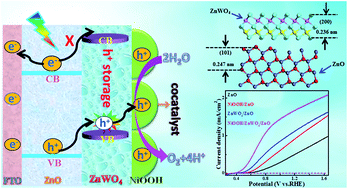Epitaxial growth of ZnWO4 hole-storage nanolayers on ZnO photoanodes for efficient solar water splitting†
Abstract
Photoelectrochemical (PEC) efficiency for water splitting is severely restricted by the high charge recombination and sluggish kinetics of the oxygen evolution reaction (OER). Herein, we demonstrated the selectively epitaxial growth of ZnWO4 hole-storage nanoplates on the top (002) facets of ZnO nanorod arrays, which could efficiently extract and store the photo-generated holes from ZnO photoanodes. Additionally, after nickel-hydroxide decoration, holes stored in ZnWO4 layers can be rapidly transferred to the surfaces of OER catalysts for PEC water oxidation. As expected, this photoanode exhibits highly improved PEC activities for solar water splitting, and a photocurrent density could be achieved up to 1.7 mA cm−2 (at 1.23 V vs. RHE), more than three times than that of the pristine ZnO photoanode. Moreover, an evident negative shift of the onset potential (∼200 mV) as well as excellent PEC stability has also been observed.



 Please wait while we load your content...
Please wait while we load your content...